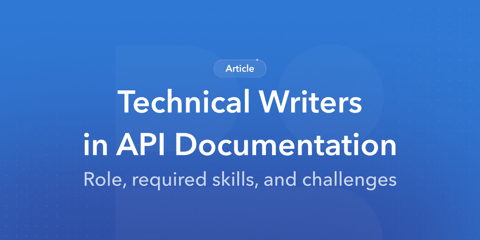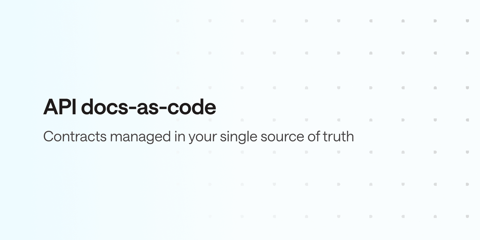The Essential Role of Technical Writers in API Design
APIs have become an essential part of software architecture and partner integrations. Many organizations today are shifting to a digital product mindset when designing and delivering APIs. As such, the importance of well-crafted API documentation cannot be overstated. At the heart of this crucial task is the technical writer, whose role extends far beyond writing documentation to include the full API design and development lifecycle. Let’s find out how technical writers can be a significant part of the API design process and how organizations should prepare to involve them throughout the API lifecycle.
The Evolution of the Technical Writer’s Role
Traditionally, technical writers were primarily responsible for creating user manuals and guides, often in the form of PDFs or HTML documents. These manuals provided step-by-step instructions for using software, requiring the writer to have an in-depth understanding of the user interface and all its features, even those less frequently used. The goal was to ensure that end users could effectively and efficiently navigate the software, thereby reducing support costs while delighting customers.
However, the role of technical writer has seen a considerable shift over the past decade. With the rise of user experience (UX) design, many organizations have replaced traditional technical writers with UX experts, whose focus is on designing interfaces that are so intuitive that they require little to no documentation. In other cases, marketing and product teams have taken over the role of enhancing the copy within applications to drive user engagement and improve conversion rates.
Despite these changes, the rise of APIs has rekindled the demand for skilled technical writers. Unlike traditional software documentation, API documentation requires writers to have a deep understanding of not just one, but often several programming languages. These may include Java, Python, GoLang, Ruby, JavaScript, Objective-C, Swift, and more. Additionally, they must be proficient in using APIs directly via HTTP and be able to demonstrate API integrations across various platforms. The audience for API documentation is also more diverse, ranging from end users to experienced developers, and even those fresh out of college.
With the adoption of continuous deployment and cloud infrastructure, the pace of releases has accelerated. No longer are there just a few major releases per year; instead, updates can occur on a weekly or even daily basis. This increased pace adds to the complexity of the technical writer’s role, making it more essential than ever.
The Importance of Involving Technical Writers in API Design
Technical writers bring an invaluable perspective to API design and documentation. Their involvement from the very beginning of the design process can significantly enhance the quality and usability of an API. By providing an outside-in perspective, they help to ensure that the API meets the needs of its target audience. Additionally, as they become familiar with the ecosystem, they gain deeper insights and domain knowledge that help them identify inconsistencies across the API portfolio.
One of the critical contributions that technical writers make to API design is their ability to ask the right questions. They probe into the purpose and intended use of each API operation, helping to refine the design before it is even implemented. This early involvement helps to avoid common pitfalls, such as ambiguous or incomplete documentation, that can lead to a poor developer experience.
Moreover, technical writers are skilled at distilling complex technical concepts into clear, concise, and actionable documentation. This is especially important for APIs, where the documentation serves as the primary user interface for developers. If the documentation is unclear or incomplete, it can lead to frustration, errors, and ultimately, a lack of adoption of the API. On the other hand, well-written documentation can enhance the developer experience, leading to greater satisfaction and higher rates of adoption.
Advantages of Involving a Technical Writer Throughout the API Lifecycle
Incorporating a technical writer into the API design process offers several key advantages:
-
Clarity and Precision in Documentation: Technical writers excel at translating complex technical details into clear, concise, and user-friendly documentation, ensuring that developers of all levels can easily understand and use the API.
-
Enhanced Developer Experience: Well-crafted documentation serves as the primary interface for developers, making the API more accessible and increasing its adoption rate. This positive developer experience can lead to greater success for the API in the market.
-
Consistency Across Releases: Technical writers ensure that documentation remains consistent and up-to-date across all API versions and releases, reducing confusion and errors for users as the API evolves.
-
Improved API Design: By asking critical questions and providing an outside perspective, technical writers help refine the API design, making it more intuitive and aligned with user needs from the outset.
-
Reduced Support Costs: Clear and comprehensive documentation reduces the need for extensive developer support, as users can rely on the documentation to troubleshoot and solve issues on their own.
-
Increased Efficiency in Development: Involving technical writers early in the design process streamlines the documentation phase, avoiding last-minute rushes and ensuring a more efficient development cycle.
-
Tailored Documentation Tools: Allowing technical writers to choose the best documentation tools and processes ensures that the documentation is not only of high quality but also created efficiently, without unnecessary friction.
-
Maintaining Documentation: As APIs evolve and new features are added, the documentation must be updated to reflect these changes. This is no small task, particularly for organizations that offer a large portfolio of APIs. It may require a team of technical writers who can dedicate themselves to both new and existing APIs, ensuring that all documentation remains accurate and up-to-date.
The Impact of API Documentation on Developer Experience
The success of an API often hinges on the quality of its documentation. For developers, the documentation is the user interface through which they interact with the API. If the documentation is poorly written, difficult to understand, or incomplete, it can lead to a negative developer experience. This, in turn, can result in lower adoption rates, as developers may choose to use a different API that is better documented.
On the other hand, high-quality documentation can significantly enhance the developer experience. It can make the process of integrating with an API smoother and more enjoyable, leading to higher levels of satisfaction and increased adoption. This is particularly important for enterprise API platforms, where APIs are often used by partners, customers, and third-party service integrators. In these cases, the quality of the documentation can directly impact the success of the API platform as a whole.
Building a Strong Technical Writing Team
Given the vast amount of work involved in creating and maintaining API documentation, it is critical for organizations to build a strong technical writing team. A single technical writer may be able to handle the documentation for a small API, but as the number of APIs grows, so too does the workload. Even the most talented technical writer would struggle to keep up with the demands of a large organization offering multiple APIs.
Therefore, it is essential to have a team of technical writers, each with a specific focus. For example, some writers can be dedicated to emerging APIs, while others focus on maintaining documentation for existing APIs. This division of labor allows each writer to specialize and become an expert in their area, leading to higher quality documentation.
Furthermore, technical writers should be involved in all API design decisions from the beginning. They should not be seen as an afterthought, brought in only at the last minute to write documentation for an already completed API. Instead, they should be treated as first-class team members, with a voice in the design process. This approach not only leads to better documentation but also to better-designed APIs that are easier for developers to use.
Decisions regarding documentation tools and processes should also be made by the technical writers themselves. Too often, developers impose specific tools on writers, which can lead to inefficiencies and frustration. By allowing technical writers to choose the tools that best suit their needs, organizations can ensure that the documentation process is as smooth and effective as possible.
Conclusion: Elevating the Role of Technical Writers in API Design
Technical writers play a pivotal role in creating this high-quality documentation. Their ability to translate complex technical concepts into clear, concise, and actionable information is what makes an API accessible and usable for developers. By involving technical writers in the design process, organizations can ensure that their APIs are well-documented from the start, leading to a better overall developer experience.
Organizations must recognize the value that technical writers bring to the table and invest in building strong technical writing teams. These teams should be integrated into the API design process and given the tools and resources they need to succeed. By doing so, organizations can ensure that their APIs are not only functional but also easy to use, well-documented, and highly successful in the marketplace.


